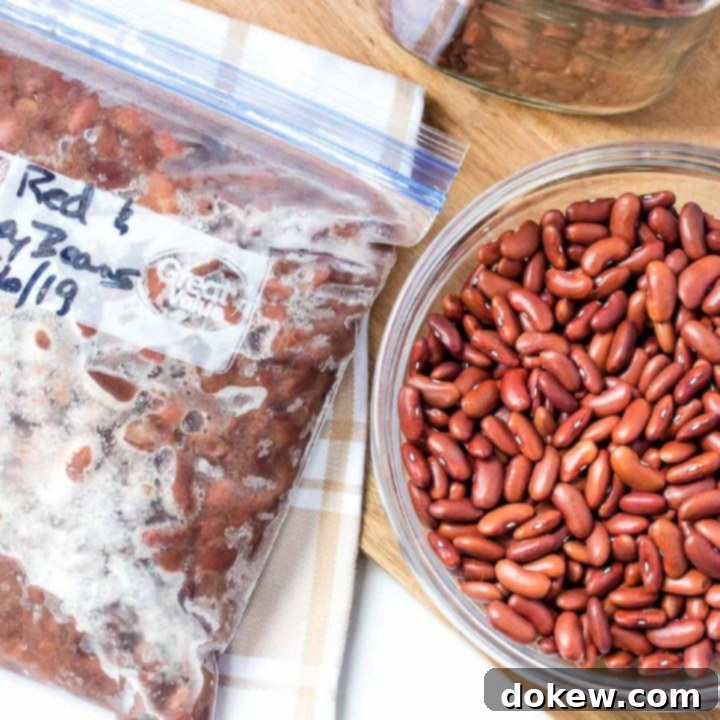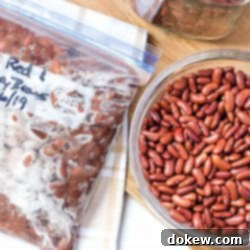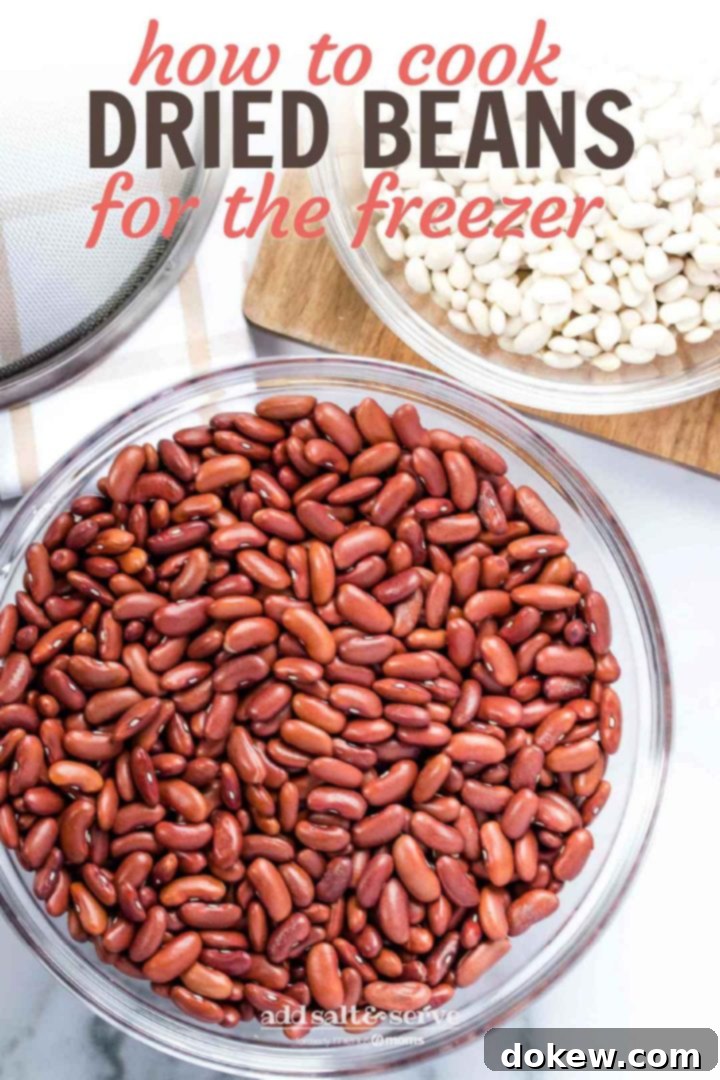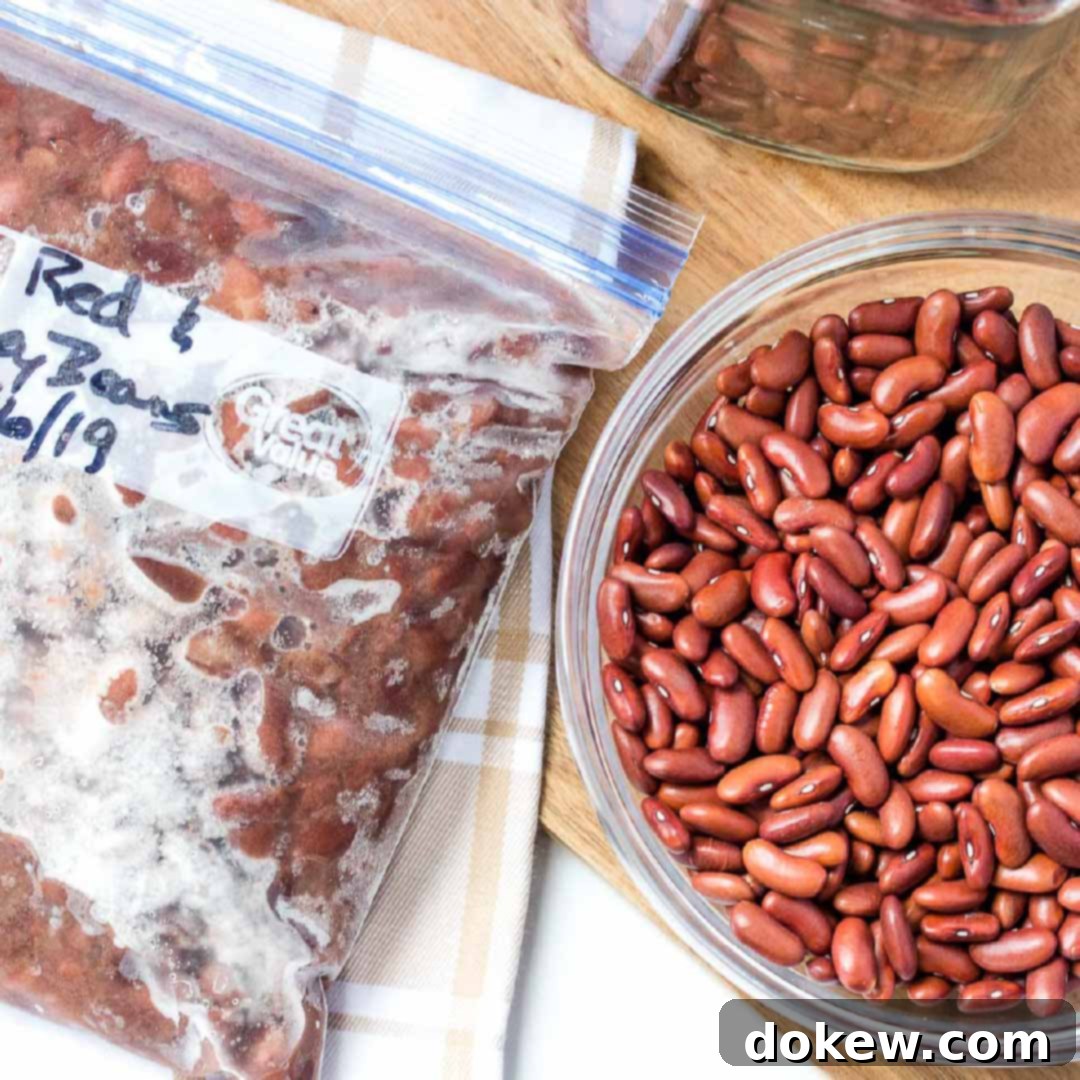How to Cook Dried Beans for the Freezer: Your Guide to Savvy Meal Prep & Savings
Embracing dried beans as a staple in your kitchen is one of the easiest and most effective ways to significantly cut down on grocery expenses. On average, dried beans cost about half the price per serving compared to their canned counterparts, offering substantial savings over time. While the process of cooking dried beans may span several hours, it demands minimal active involvement, requiring only occasional checks. This comprehensive guide will walk you through cooking a batch (or two, if your pot allows!) of dried beans and freezing them in convenient 2-cup portions, complete with their own flavorful cooking liquid. Each frozen portion can then be used interchangeably with a standard can of beans in your favorite recipes, including those featured in our meal plans.

Why Choose Dried Beans Over Canned?
Beyond the undeniable cost savings, opting for dried beans provides a multitude of benefits that elevate your home cooking and contribute to a healthier lifestyle. Let’s explore why making the switch is a smart choice for any kitchen.
Significant Cost Savings
The primary driver for many home cooks to embrace dried beans is the remarkable difference in price. A single pound bag of dried beans, which yields approximately 5-6 cups of cooked beans (equivalent to 2-3 cans), typically costs less than a single can. Over the course of a year, especially if beans are a regular part of your diet, these savings accumulate quickly, freeing up your budget for other groceries or household needs.
Superior Nutritional Value and Control
When you cook dried beans from scratch, you have complete control over the ingredients. Canned beans often come with added sodium and sometimes preservatives. By preparing your own, you can ensure your beans are free from unwanted additives, allowing you to season them precisely to your taste and dietary requirements. Dried beans are also a powerhouse of nutrition, packed with fiber, protein, and essential vitamins and minerals like iron, folate, and potassium, contributing to a well-balanced diet and promoting digestive health.
Enhanced Flavor and Texture
Many chefs and home cooks agree that freshly cooked dried beans boast a richer, more authentic flavor and a superior texture compared to their canned counterparts. Canned beans can sometimes be mushy or have a metallic aftertaste. Cooking dried beans yourself allows them to absorb flavors from your chosen seasonings and liquids, resulting in a more delicious and satisfying culinary experience.
Environmental Benefits
Choosing dried beans also has a positive impact on the environment. By purchasing beans in bulk or in bags, you reduce the amount of waste generated from single-use cans. This small change in your grocery routine contributes to a larger effort towards sustainable living and minimizing your carbon footprint.
Choosing the Right Dried Beans for Your Kitchen
The world of dried beans is vast and varied, each type offering unique flavors and textures suitable for different dishes. For freezer meal prep, almost any variety of dried bean works wonderfully. Some popular choices include:
- Pinto Beans: Known for their creamy texture and earthy flavor, perfect for refried beans, chili, or served simply over cornbread. Pinto beans cooked with chopped onion (about 1-½ onions per pound of beans) are delicious served over cornbread with chopped onion and shredded cheddar cheese on top. Season the beans to taste with salt and pepper after cooking is complete.
- Black Beans: A staple in Latin American and Caribbean cuisines, great for soups, tacos, burritos, and salads.
- Kidney Beans: Firm and hearty, ideal for chili, stews, and cold bean salads.
- Great Northern Beans: Mild flavor and tender texture, excellent in soups, casseroles, and baked bean dishes.
- Navy Beans: Small, white beans that become wonderfully creamy when cooked, often used in baked beans and soups.
- Cannellini Beans: Also known as white kidney beans, these have a nutty flavor and a soft interior, perfect for Italian dishes, salads, and spreads.
No matter which variety you choose, the cooking and freezing method outlined below remains consistent, making it incredibly versatile for your culinary adventures.
Recipe: How to Cook Dried Beans for the Freezer

How To Cook Dried Beans for the Freezer
Add to Shopping ListGo to Shopping List
Ingredients
- 1 lb. bag dried beans, e.g., black, pinto, kidney, great northern, navy, cannellini
- water
- Optional: salt and pepper to taste (add after cooking)
- Optional: 1-½ chopped onions per pound of beans (for pinto beans)
Instructions
-
Prepare the Beans: Begin by thoroughly rinsing your dried beans in a colander under cold water. While rinsing, carefully inspect the beans for any small stones, debris, or shriveled beans, discarding anything that doesn’t belong. Transfer the cleaned beans to a large pot. Cover them with fresh water, ensuring the water level is at least twice as deep as the beans. This ample water allows for proper hydration during soaking. Let the beans soak for a minimum of 5 hours, or preferably overnight, to rehydrate them. Soaking helps to reduce cooking time and can improve digestibility.
-
Cook the Beans: After soaking, drain the beans completely in a colander and rinse the pot thoroughly. Return the soaked beans to the clean pot. Add fresh water, again covering the beans generously (at least 2-3 inches above the bean level). Bring the water to a boil, then reduce the heat to a gentle simmer. Cook until the beans are tender. The cooking time can vary significantly, ranging from 45 minutes to 2 hours, depending on the type and age of the beans. Test for doneness by tasting a few beans – they should be soft and creamy, not crunchy. Throughout the simmering process, check the water level periodically and add more hot water if needed to keep the beans submerged.
Alternatively, you can cook the beans in an Instant Pot or pressure cooker for faster results. Refer to the Instant Pot website’s cooking times for guidance on specific bean varieties. When using a pressure cooker, it’s crucial to monitor food and water levels carefully, as beans tend to foam while cooking. The inner pot should never be more than half full to prevent overflowing and ensure safe operation.
-
Prepare for Freezing: Once the beans are cooked to your desired tenderness, carefully drain them, making sure to reserve the cooking liquid. A great way to do this is to place a colander over a large pan or bowl, then pour the beans into the colander; the bowl will catch all the flavorful liquid. Allow the beans and liquid to cool completely to room temperature. Once cooled, separate the cooked beans into 2-cup portions, which is roughly equivalent to one standard can of beans. Place each portion into freezer-safe bags or airtight containers. Cover the beans in each bag or container with a generous amount of the reserved cooking liquid. This liquid helps to protect the beans from freezer burn and maintains their texture and flavor upon thawing. Seal the bags or containers, removing as much air as possible, and freeze flat for easy storage. Label each package with the date and type of bean. Cooked, frozen beans can be stored for up to 3 months.
Nutrition per serving
Share
Pin
Pin this recipe:

Thawing and Using Your Frozen Beans
Having a stash of pre-cooked, frozen beans in your freezer is a game-changer for quick and healthy meals. When you’re ready to use them, there are several convenient ways to thaw and incorporate them into your cooking:
- Overnight in the Fridge: The safest and most recommended method is to transfer the frozen bag or container of beans to your refrigerator the night before you plan to use them.
- Quick Thaw in Water: For faster thawing, place the sealed freezer bag of beans in a bowl of cold water. Change the water every 30 minutes until thawed.
- Microwave: If you’re in a hurry, you can thaw beans in the microwave using the defrost setting, stirring occasionally to break up clumps. Be careful not to cook them.
- Directly into Hot Dishes: For soups, stews, or chili, you can often add frozen beans directly to the simmering pot. The liquid from the frozen beans will melt and incorporate into your dish.
Once thawed, your home-cooked beans are ready for anything! They’ll retain their excellent flavor and texture, acting as a perfect substitute for canned beans in any recipe. They’re fantastic for quick weeknight dinners, meal prepping for the week, or whenever you need a boost of plant-based protein and fiber.
Delicious Recipes that Use Dried Beans:
Now that you’re a pro at cooking and freezing dried beans, it’s time to put them to good use! Here are a few of our favorite freezer-friendly recipes that benefit immensely from your pre-cooked bean stash. Give one of these a try or see all of our dried bean recipes for more inspiration.
- Nacho Bar
- Old Fashioned Pinto Beans Over Cornbread
- Black Bean Soup
- Burritos Mojados
Embrace the Dried Bean Difference
Cooking dried beans for the freezer is a simple yet impactful strategy to enhance your cooking, save money, and make meal prep significantly easier. By taking a little time upfront, you equip yourself with a versatile, nutritious, and cost-effective ingredient that can be seamlessly incorporated into a myriad of dishes. Say goodbye to expensive canned beans and hello to flavorful, homemade goodness that’s always ready when you are. Start your dried bean journey today and experience the difference!
